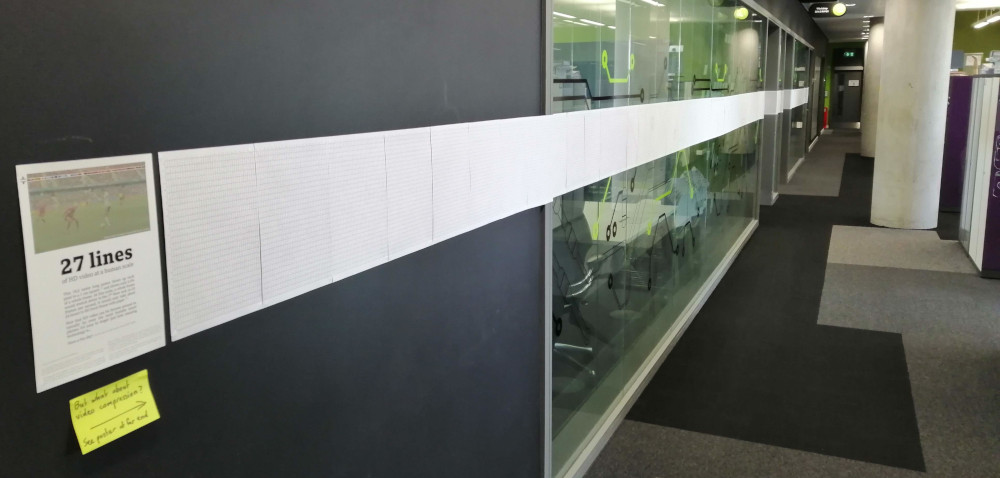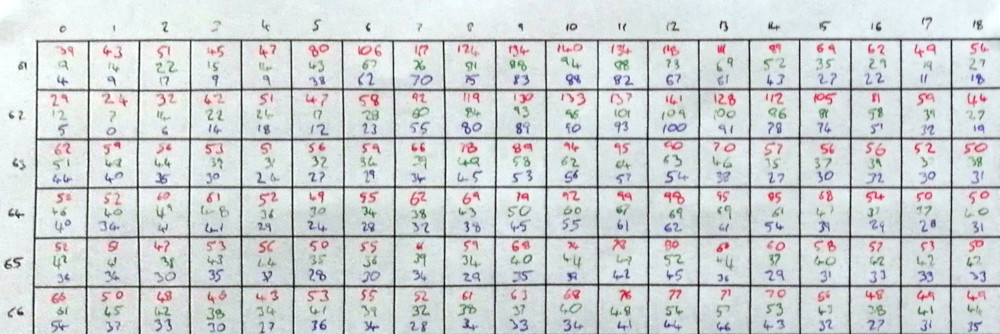27 Lines of HD Video
This 19.2 meter long poster blows up each pixel to a 1 cm square with the quantity of red, green and blue for that pixel written inside. The poster shows only 27 of the 1080 lines a HD video frame (2.5%). At this scale, a whole frame would stretch over 3-4 floors and, at 25 frames per second, it would only take about 24 hours to fill a typical office building.

A close-up of the pixel values printed on the poster is shown below.

The actual frame of video used was taken from the BBC's coverage of the 2019 Women's World Cup. The on-screen graphics along the top of the frame are just about small and contrasty enough to be visible on the poster.

You can download a copy of the poster here.
You can also download an explanatory poster here along with a companion poster showing the effectiveness of modern video compression techniques.
Why?
I'm currently working on the ultra-low-latency VC-2 video codec and this has set me thinking about just how incredible technology is these days. We live in a world where a low-end smart phone can now play HD videos, streamed over a mobile internet connection no less, without breaking a sweat. Meanwhile the (fairly misguided) 4K and 8K Ultra High Definition (UHD) formats are starting to appear. This poster tries to put into perspective just what an incredible feat it is to push around even basic HD video at all!
To add to this, modern video codecs are able to compress the amount of data on this 20 meter long poster into the equivalent of just half a page of numbers:

Handwriting
I originally wondered how hard it would be to hand write a whole HD frame and my back-of-the-envelope calculations made me realise I had much better things to do than spend about 4 solid days scratching away. Instead this poster was made using a hacked-together handwriting synthesiser.
The synthesiser works first by getting a modest number of samples of my handwriting (a scan of a sheet where I'd written out the numbers 1 to 100) and this is vectorised:

The script is a mess so not suitable for sharing but works by first skeletonising the bitmap image and then using a simple flood-fill algorithm to follow the skeletons of each digit to produce a vector path.
Multi-digit numbers are created by choosing random digit samples from the captured handwriting and scaling and shifting each slightly to give a more realistic look.
Initially I tried using a pen plotter using a real pen to write the digits. Unfortunately this proved too slow taking about twenty minutes per A4 page. With 91 pages of numbers to produce, I decided to use a pair of SVG filters to make the lines vary in thickness and colour in a similar fashion to a ball point pen.

An aside on video compression...
The kinds of video compression which can compress this 20m poster into the handful numbers above are actually quite different from the codec I'm working on (VC-2).
The incredible compression schemes used to deliver video over the internet (such as H.264 and HEVC) can achieve compression ratios of 100:1 or better as illustrated above. To do this, however, these systems are incredibly complex requiring huge amounts of computer power and introducing as much as tens of seconds of delay as video streams are compressed. In addition, in order to achieve such high compression ratios, pictures are reduced in quality. If a video compressed in this way is decompressed and then recompressed again the loss in quality quickly becomes unacceptable.
The processing power requirements, significant delay and loss of quality during recompression all make this type of compression unsuitable for use in TV and movie studios. Here, the delays make the job those behind the scenes in live TV productions impossible and the loss in quality would result in unwatchable final results.
By contrast, VC-2 is designed to achieve much lower compression ratios of around 4:1, however it is able to do so with dramatically reduced delay and without any visually discernible loss of quality. Specifically, VC-2 can introduce as little as a few millionths of a second of delay and video encoded with VC-2 can be decoded and re-encoded an arbitrary number of times without incurring further loss in quality.
Though a 4:1 compression ratio is not enough to allow you to stream even low resolution video over a typical home internet connection, it is enough to squeeze 4K video, or high-frame-rate HD over existing (uncompressed) HD video links.
VC-2 is a mature technology and has been around for a long time -- for example early versions were used by the BBC during the Beijing 2008 Olympic Games to squeeze HD pictures over the lower resolution SD video links available at the time. Since then VC-2 has found its way into many cutting edge broadcast operations -- including this year's Wimbledon tournament.
